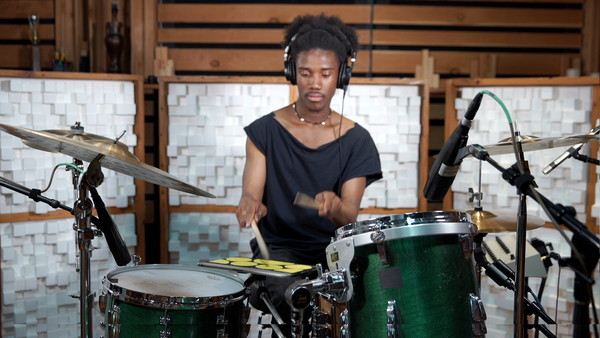Get the Rhythm Right: When to Choose the Drum Pad and Music Production Overlays
When it comes to playing drums electronically, there are two classic instrument controller methods: drum pads and sampler pads.
Drum pads were pioneered in the late 70s by Simmons and continuing in popularity to this day with instruments like the Roland SPD series and the DrumKat. The goal is to approximate the expressiveness of playing an acoustic drum. With larger pad areas that accommodate drum sticks, drum pads are great for trained acoustic drummers, or anyone looking for a larger range of nuance in a performance. They do, however, take up more space.
Sampler pads were pioneered in the 80s with the Akai MPC series and later championed by contemporary classic machines like the E-Mu SP1200 and Boss SP-303. These pads are smaller and designed for finger drumming and triggering loops. In the classic arrangement of a 4x4 grid, sampler pads facilitate easy sound triggering in a smaller area, giving you an instrument with more sounds and room for more controls. Additionally, because we’re using all ten fingers, sampler pads allow for virtuoso playing from artists like DiVinci or AraabMuzik.
DiVinci live on three MPCs
Which one is for you?
First off, the great news about the Sensel Morph is that you don’t have to choose. By easily swapping overlays, you can find the control scheme that’s right for you, every time.
The Drum Pad Overlay for the Morph provides a drum pad-style layout. Each pad area is larger, and the pads are arranged like a standard acoustic drum kit. With the exception of the kick, each pad on the Drum Pad has two sections, allowing for either different sounds, or for mapping to different articulations (for example, using one area for a closed hi-hat sound, and the other for an open hi-hat sound).

Nate Hendrix on the Drum Pad Overlay for Sensel Morph
Due to the larger pad area, the Drum Pads can capture more nuanced performances – it’s easier to hit one pad area with two fingers to do a roll. By default, the X axis of each pad acts as a pitch-bend – perfect for tuned percussion models or samples, such as tabla or gamelan.
The Drum Pad is also a robust overlay – smack it with drum sticks, or even put it on the floor and use it as a stompbox or expression controller! It’s easy to integrate into a drum set and add electronics to your kit.
The Music Production Overlay for the Sensel Morph
The Music Production Overlay gives you a classic 4x4 pad layout, along with eight knobs, two sliders, and an octave bass keyboard. If you’re looking to finger drum or trigger samples from one hand, the MP overlay is what you want.
The MP overlay also makes it easy to map to many software samplers. From DAW-based offerings like Ableton Live’s Drum Racks and Bitwig Studio’s Drum Machine to dedicated plugins like FXPansion’s Geist, the 4x4 pad grid is easy to match between the MP overlay and software, without any extra mapping. Flip through drum kit presets, or drag and drop your sounds and start playing!
The MP overlay is especially great as a finger instrument. With less distance between the pads, it’s easier to trigger your sounds. Plus, you’ll quickly find that working with a pad grid gives you the muscle memory to not have to look much at your hands. Lastly, if you’re looking to tweak effects with one hand while you play with the other, the MP Overlay can’t be beat.
Beat BundleBy now you probably realize that there are times when you might prefer the Drum Pads, and times when the Music Production is more what you want. The good news is, you don’t have to choose! With the Morph Music Maker’s Overlay, you get the Drum Pads, Music Production, and Piano overlays together as a bundle with your Morph.
What are you making with your Morph? Which do you prefer for laying down your beats? Let us know on Instagram, Facebook, and Twitter!

